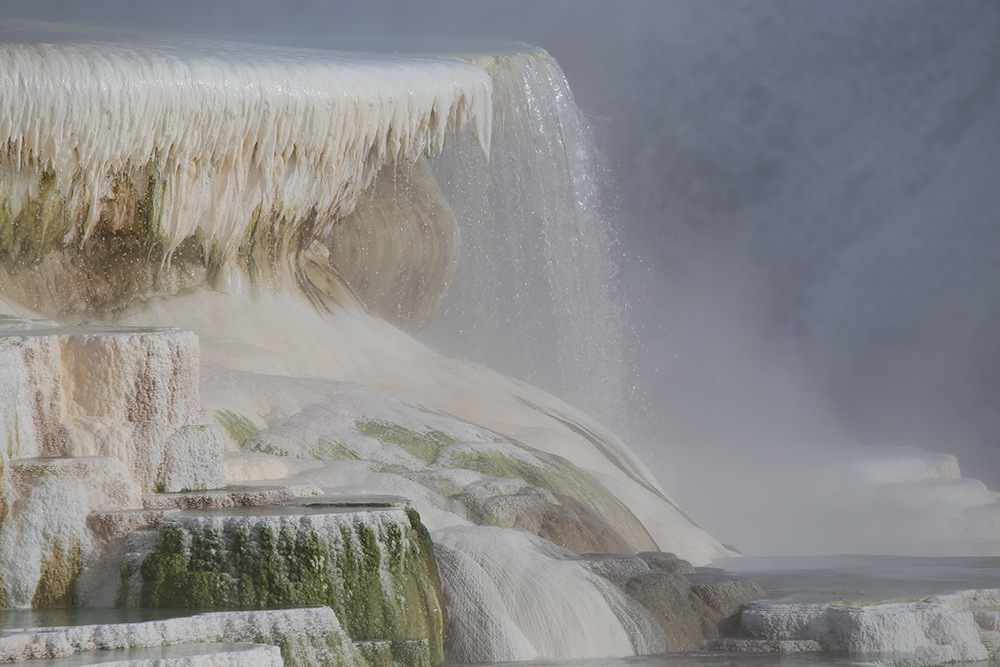This was our second to last full day in Yellowstone, and we started the day with some cross-country skiing in the park. We stopped in Mammoth to pick up our ski gear, and went off to the Upper Terrace Loop trail. We were all excited to get out, but most of the group had never XC skied before…so it was going to be quite an adventure!
The trail was very moderate and lead us to views of hot springs, terraces, and the surrounding mountains. The last half of the 1.5 mile loop had a bit of a curvy downhill section through the trees. For the skilled downhill skiers, this was a piece of cake. However, for those who had never skied before or weren’t familiar with these edgeless skis, this part of the trail was going to be interesting.
Fortunately, we all made it through the loop without any injuries, and many of us opted to head back out for another lap or two.
After lunch we came together to learn about animals living in the Anthropocene, the current geological epoch where human activity has been the dominant influence on climate and the environment. Dr. Lambert explained the two major effects of human-wildlife conflicts in this epoch tend to be related to economic issues, as well as health and safety concerns. Economic effects could be from property damages from wildlife, livestock loss from depredation, costs from zoonoses to pets or livestock, and more. Health and safety concerns general refer to injury and death to humans, pets, and livestock.
On the other end of the spectrum, numerous species of wildlife are suffering from mass extinction. Currently, we’re going through the 6th mass extinction of plants and animals and are on track to lose as many as 30-50% of the total species by 2050.
However, it was interesting to explore how some species are adapting to their Anthropogenic environments. Animals such as raccoons are thriving in human-dominated landscapes and become bolder, keeping smaller home ranges, becoming more socially tolerant, and are existing in greater abundance. Now humans and wildlife are learning to coexist and the general awareness of biodiversity in urban areas is increasing.
The take home message? What you do in your own back yard matters! We should all consider ways to connect patches of habitat in city areas by planting trees, establishing natural corridors, and of course planting native species.
Later on, Colby Anton, a PhD student from UC Santa Cruz, came by to talk to us about his work with the Yellowstone Cougar Project. This project follows an eight-year gap in research on cougars, and aims to monitor the dynamics and ecological influence of Yellowstone’s big cat, as well as the effects of predator diversity.
Colby has worked numerous jobs with large predators, ranging from grizzly bears in Alaska, with the US Forest Service on black bear management in California, and with black bears and cougars in Colorado and Utah. Currently, he is examining the diverse relationships between pumas, wolves and their main prey, rocky mountain elk, within the Northern Range of Yellowstone National Park. His work primarily involves non-invasive genetic sampling, which includes camera trapping, and analyzing hair, scat, and blood samples left behind by the cougars. Additionally, the Yellowstone Cougar Project team is capturing and collaring cougars each winter with advanced GPS satellite collars with activity trackers. These collars not only provide detailed stories about predation and habitat use, but also cutting edge information on animal energetics, or caloric costs and gains.
When asked about human conflicts with mountain lions, Colby told us most people in the area seem to be fascinated by cougars. It’s a very different situation as opposed to wolves. Unless there is some type of incident or conflict, most people aren’t bothered by the presence of mountain lions. Why? Probably because they don’t ever see these elusive animals.
Check out this video captured by the cougar team’s camera trap:







